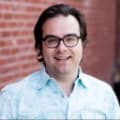It would be a daunting task, for sure, regardless of what I was driving: I'd have to navigate some of the world's most congested and confusing thoroughfares, all while keeping my very important passengers safe and comfortable.
But I was confident that things would go well. The all-new Chrysler 200 is the result of a $1 billion investment in a revamped assembly line in Sterling Heights, MI, and takes full advantage of new technology brought on board after Fiat's acquisition of Chrysler. It arrived at my house with the tacit promise that the company had finally built a competitive midsize sedan. At the very least, it would do the trick on a weekend road trip.
{{ photo_gallery name="Exterior" }}
"That's a Chrysler 200?" My wife was taken aback by the new car, which she initially feared would look and drive like the old 200s she'd encountered at airport rental lots.
The old car was little more than a tired Sebring in an expensive suit. The 2015, however, is a completely different car that features the same basic underpinnings as the Dodge Dart and Jeep Cherokee, a vastly updated interior, and totally new sheetmetal.
One aspect of that redesigned exterior got our trip off to a shaky start: Dad hit his head on the sharply raked C-pillar while getting into the rear seat. But he soon forgot about his injury after settling in. His overall verdict on the rear seat? A comfortable spot, but watch your head.
If Dad hadn't brought a few magazines, I probably would've fired up the car's $19.95/week mobile 3G hotspot so he could read the news on his iPad. It's slower and more expensive than GM's 4G connection, but it's enough to keep most passengers pacified.
{{ photo_gallery name="Interior" }}
I say "most" because my mother just may be the world's most nervous passenger. Lucky for her, the 200 I drove came with a suite of driver-assist technologies that kept another pair of eyes on the road, so she could relax and let the machines worry about my driving.
I expected to end up in New York City right at rush hour, so I set the adaptive cruise control to 65 and let the car drive itself—even through stop and go traffic. It's part of a $1,295 SafetyTec package, which also includes rain-sensitive wipers, brake assist, automatic high beams, a park assist program that helps drivers whether they're parallel or perpendicular parking, and a blind spot detector that mercifully allows the user to turn off auditory alarms.
Those systems were all unobtrusively helpful, and kept my mother calm enough to enjoy views of the Hudson River. I found no claw marks on the rear-seat armrest.
{{ photo_gallery name="Tech" }}
However, I did have an major issue with lane-keep assist. It's designed to steer the car back into a marked lane, which sounds like a great idea. But I uncovered some teething problems: if you don't keep your turn signal on throughout the entirety of a lane change, you'll feel the steering wheel start to pull. And on one under-construction portion of I-95, the system became confused by a set of temporary lane lines that overlapped existing ones. As the wheel pulled left and right, it felt like I was driving through nasty crosswinds.
Aside from that electronic intervention, the car handled well. The 200C I drove had the optional touring suspension, and I was impressed by its stability in curves and how well it absorbed bumps.
That's not to say it feels numb. Steering is crisp, and overall the car feels stiffer than a Camry and more forgiving than a Passat. Aside from a dull brake pedal feel and a tendency to float over larger road imperfections, the 200 is nimble—especially among cars in its class.
Acceleration wasn't an issue, either. Under the hood was Chrysler's updated TigerShark 2.4-liter engine, which features Fiat's MultiAir variable valve timing. (A six-cylinder is optional—but mandatory if you choose all-wheel drive.) Its efficiency-minded power delivery is more reminiscent of a commuter ferry than a runaway train, but it gave all it had whenever I asked.
That four-cylinder engine is mated to the same 9-speed transmission that debuted on the Jeep Cherokee. On the 200, it had no problems finding the most efficient gear for climbing, passing, or cruising—which wasn't the case when I drove an early-production Cherokee. I got around 27 mpg in a mix of city and highway driving.
Of course, a car's infotainment system is of utmost importance on a long road trip through unfamiliar territory. With its giant buttons and 8.4-inch touchscreen, Chrysler's UConnect system proved as easy to use as a See 'N Say. It occasionally had trouble with voice recognition, and sometimes came up with odd routes around traffic, but generally got us where we needed to go.
The wedding was lovely. The car stayed safely parked during (and after) the reception, and the next day we even had time to stop in the East Village for lunch to break up the drive home. Through it all, the 200 was a constant companion, offering ample trunk space for suitcases, cubbyholes for snacks and umbrellas, and plenty of leg room. After 800 miles, I was sad to see it go.
Yes, there's some sentimentality involved in that statement, but I still think I would've felt the same way if I'd just driven it to and from work. Cars like the Chrysler 200 aren't designed to impress others or pamper drivers. They exist to maintain the rituals of everyday life. For its part, the new 200 makes the mundane a little bit more special.
Meet the tester
Keith was the Editor in Chief of Reviewed's appliance and automotive sites. His work has appeared in publications such as Wired, Car & Driver, and CityLab.
Checking our work.
Our team is here to help you buy the best stuff and love what you own. Our writers, editors, and experts obsess over the products we cover to make sure you're confident and satisfied. Have a different opinion about something we recommend? Email us and we'll compare notes.
Shoot us an email

